That suggestion was made in one of the detours we took in the transverse wave thread regarding the validity of the analysis in the Gatti-Bono climbing loop paper. Many people said they had never seen such a loop and had reservations about her approach.You could do a related experiment by hitting a short section of hanging fly line with the exhaust stream from a vacuum cleaner and see if it rotates to some angle where the downward gravitational force on the fly line reaches an equilibrium angle that depends on the drag-induced lift it has from the air stream
My experience in viewing a lot of casting videos is different as it seems to me the loop stays in the air much longer than you would expect if the loop height was dominated by free fall effects as it propagated. For example here is an example where the red dots that tracked the top of the loop in Tom Syversen’s slow motion video of a narrow loop with a long inclined section of line on the bottom of the loop had increasing y values as the loop propagated.
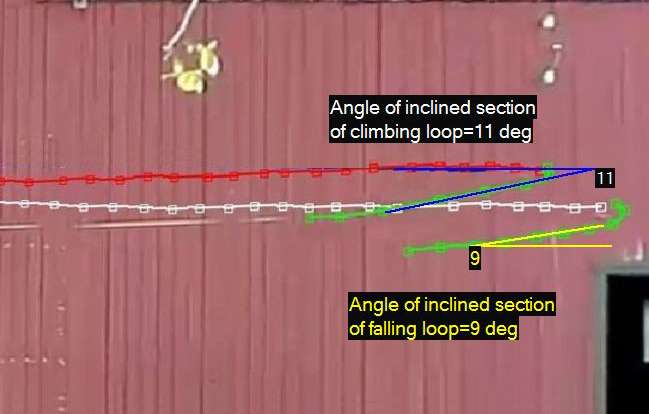
In Tom’s example it appears the track(red squares) for the loop where the inclined section of line was tilted by 11 degrees actually climbed. The loop with a 9 degree inclination did not have enough lift to climb, but still fell at a much slower rate than you would expect if there was not some lifting force to offset the effects of gravity.
With the help of Dr. Graig Spolek I did some number crunching to see what exposing a tethered length of fly line to different wind velocities might reveal about how much upward force is produced by form drag on an inclined section of fly line. If the air stream is uniform (no so easy to do in practice) then the drag force and the gravitation force along the line will be uniform, and the line will reach a steady state angle where the moment produced by the FD drag force * a moment arm of L/2, will equal the moment produced by the weight of the line * its moment arm of L/2*cos(theta). Dr. Spolek's diagram showing this moment balance situation is shown below:
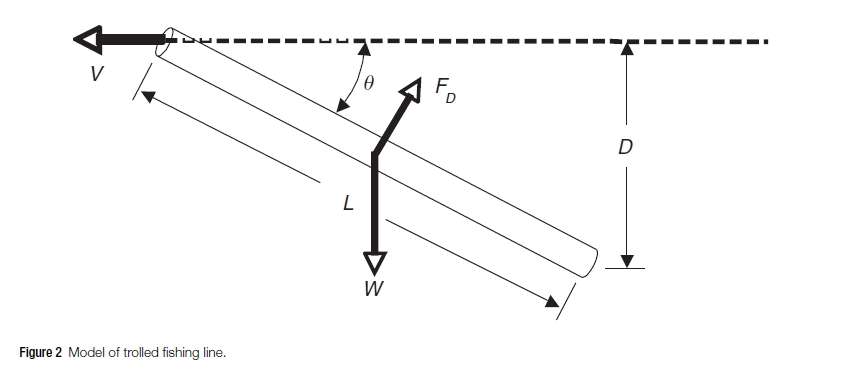
As he summarized in his paper:
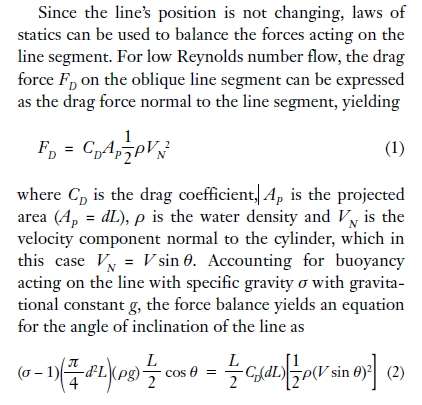
This moment balance equation that determines the tilt angle for a given wind velocity was solved for the 8wt line parameters used in this experiment (I used the fzero routine in MATLAB) to produce the curve below.
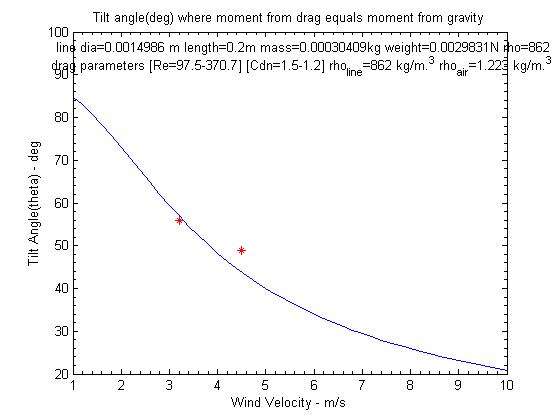
The parameters used for the line are noted in the plot. For the Reynolds numbers expected for this range of wind velocities the Cdn form drag coefficient ranged from 1.5 for a velocity of 1 m/s to 1.2 for the upper velocity of 10 m/s.
Here is short clip of a test showing that the line was surprisingly stable for this air flow of around 3.2 m/s. The dark lines in the video are from the shadows of the fly line and a thin piece of string. I naively thought I could use a thin string to get an idea of how uniform my airstream might be, but since the tension at the end of the string was so small it tended to have a lot of flutter. My .2 m length 0f fly line was much stiffer, so it tended to maintain a reasonably straight shape with little or no flutter.
There was a small amount of angle change for the fly line, but its nominal tilt angle was 56 degrees for the 3.2 m/s wind speed as shown in the measurement below.
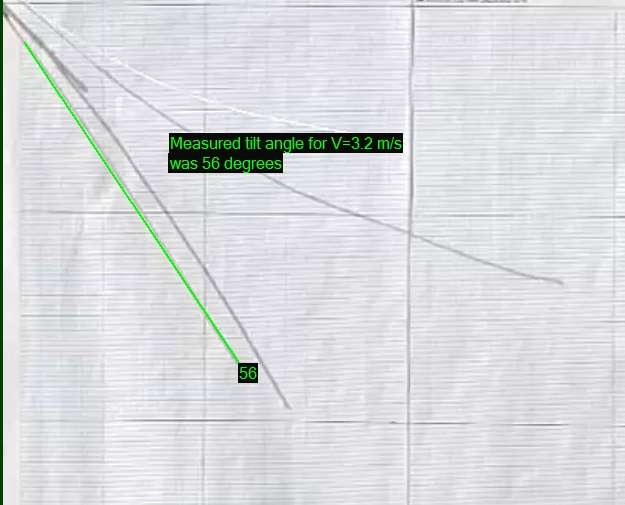
The red markers on the tilt angle vs velocity graph show the measured tilt angles for wind velocities of 3.2 m/s and 4.5 m/s. No doubt the airstream I produced with a floor tool attachment on the exhaust of a shop vacuum was not uniform, but you can see the measured values were reasonably close the theoretical curve.
In an actual cast the angle of the inclined section of line would depend on the loop shape not on a moment balance as it was in this experiment. To get an idea of the lift you would expect for the 1 meter length of line having a tilt angle of 11 degrees as measured in Tom’s climbing loop shape here is a plot of how that vertical force (Fd*cos(theta)=the lift component) on the inclined section of a 5wt fly line compares to downward –y directed force of gravity and skin drag (Fs*sin(theta)) over a wider range of loop propagation speeds.
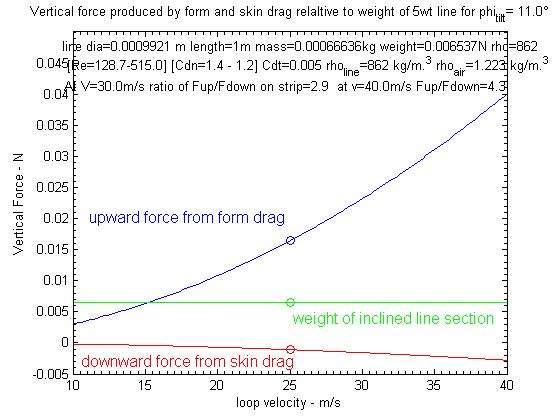
The weight of the total loop would be larger than just the weight of the inclined line section, but as shown in the above graph the lift on the inclined section of line would exceed the weight of that section for loop velocities higher than 15 m/s. For a loop speed of 40 m/s the lift due to form drag would be about 4.3 times higher than the combined downward force from gravity and skin drag on that 1 meter tilted line section.
That Fup/Fdown ratio would be smaller for a heavier line since the form drag varies with the diameter of the line while its weight would vary as its diameter squared. Thus I would doubt you would ever see a climbing loop with a full sinking fly line.
Gravity and drag produce relatively small forces (line weight was .0065N for this example) but if you can produce a narrow Sexyloop shape with high line speeds it would not surprise me to see that they would seem to defy gravity and stay airborne much longer than you would expect for a loop with no upward force from form drag.
Gordy
